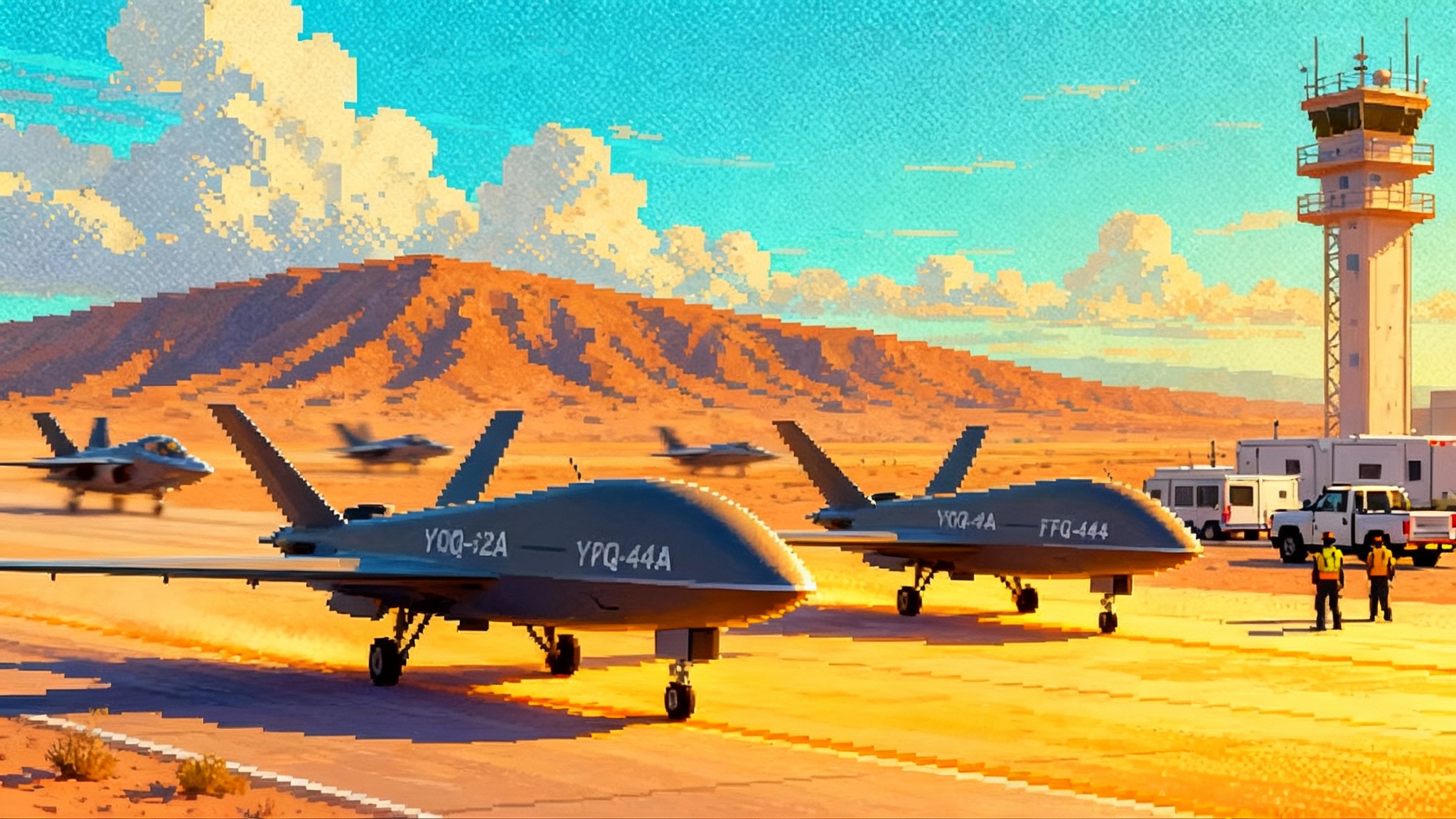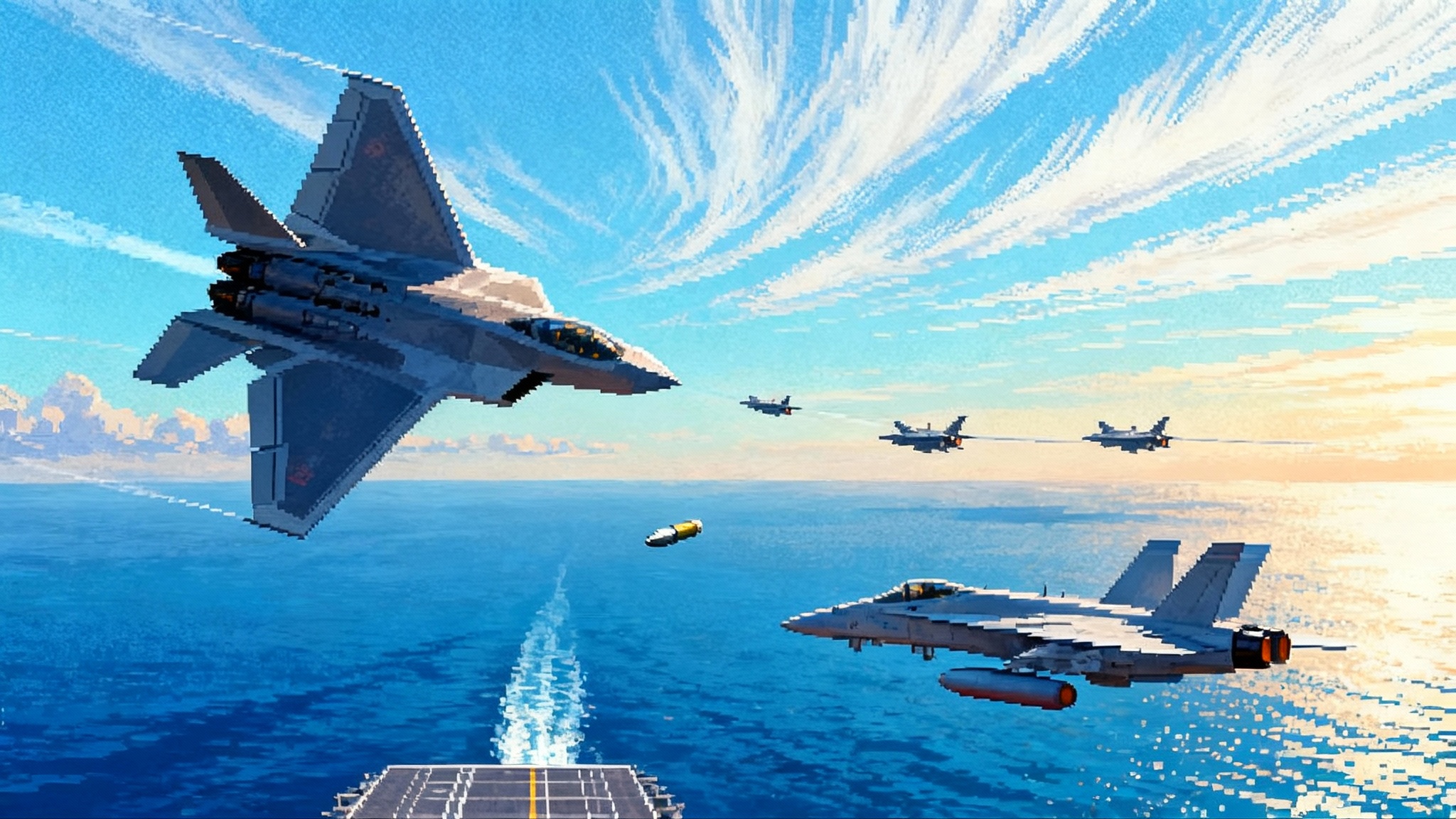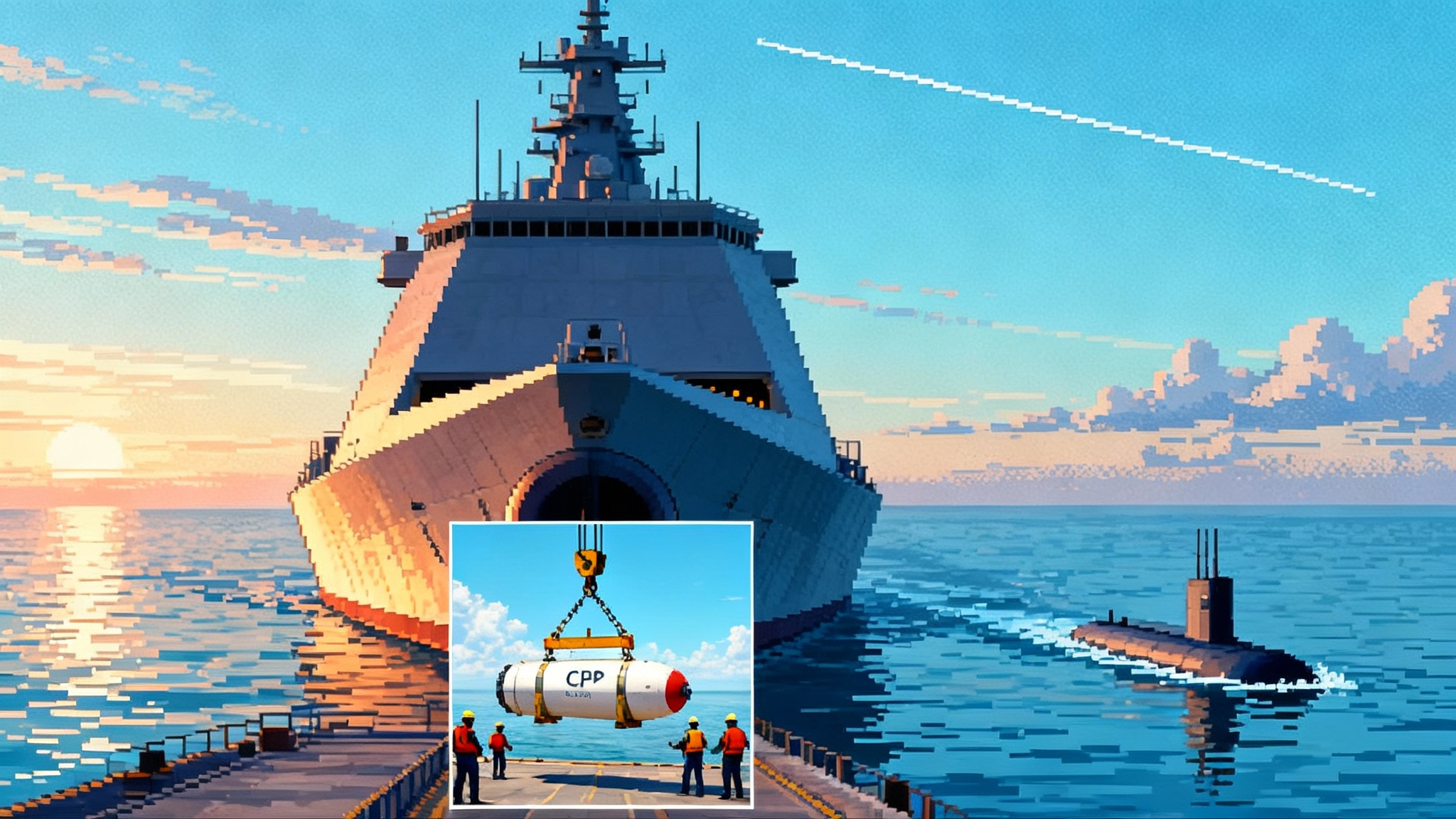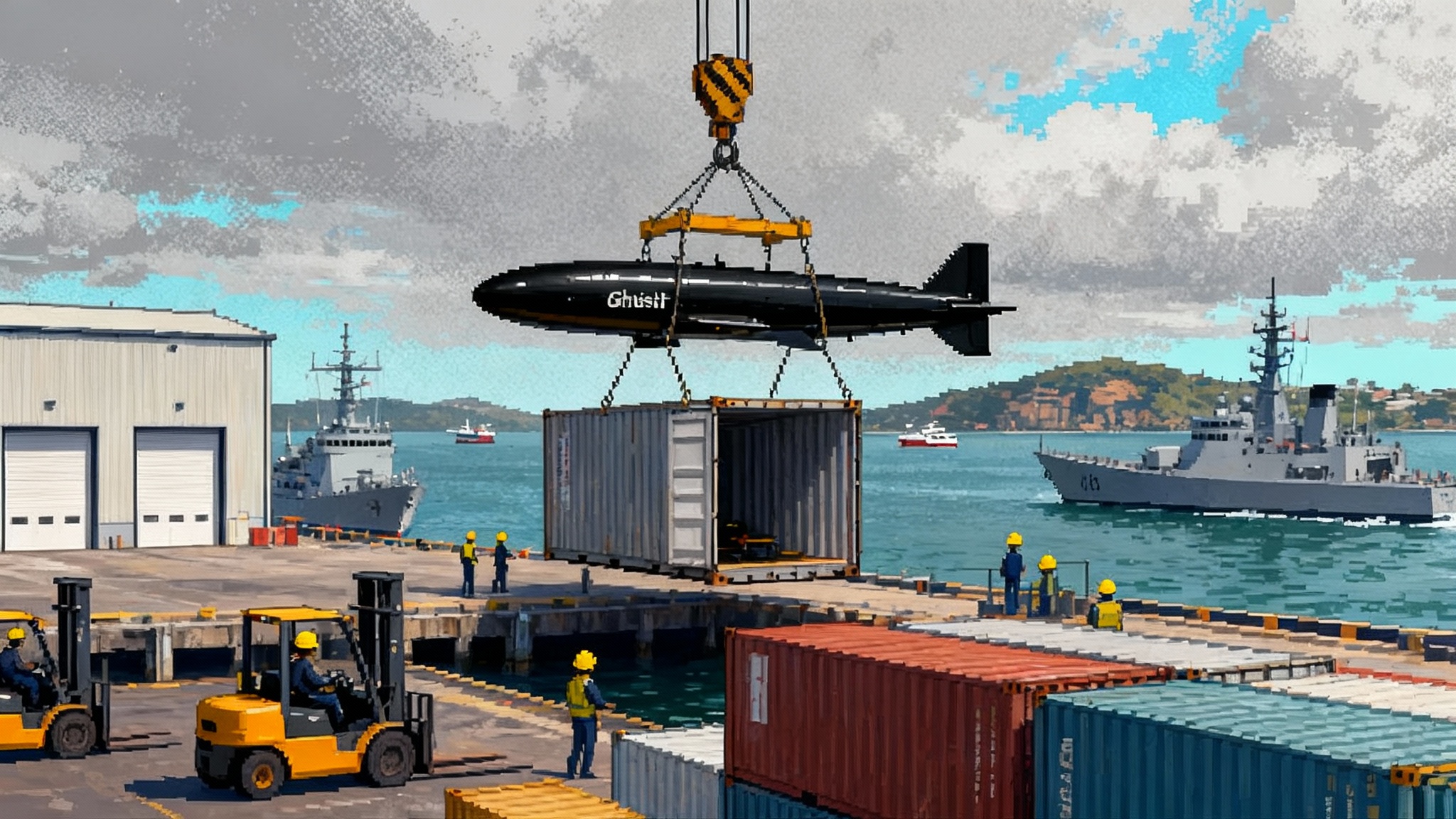USAF loyal wingmen fly: YFQ-42A and YFQ-44A begin tests
Two uncrewed fighter prototypes flew in late 2025, moving the Air Force’s Collaborative Combat Aircraft from vision to flight test reality. Here is what flies next, why software and open architectures matter, and how a 2026 decision could reshape airpower.

The loyal wingman era starts on the ramp
On October 31, 2025, Anduril’s YFQ-44A made its maiden flight in California, flying semi autonomously from takeoff to landing under human oversight. The sortie was short, controlled, and historic. It marked the first public proof that the U.S. Air Force’s Collaborative Combat Aircraft program is no longer a slide deck. It is an airplane. Reuters’ report on the first flight captured the milestone and the intent to build combat mass with autonomous teammates in the Pacific, including an Anduril plan to stand up production in Ohio as early as 2026.
A few weeks earlier, General Atomics’ YFQ-42A lifted off for the first time on August 27, 2025, beginning flight tests that validate its airframe, autonomy, and mission systems. The company confirmed the start of flight testing the same day; see GA-ASI’s statement on first flights for baseline facts and test goals.
With both jets airborne in late 2025, the idea of a loyal wingman is shifting to program reality. Two paths, one objective. Anduril leans into software speed and a commercial-style factory footprint. General Atomics brings decades of unmanned aviation production and a test culture shaped by Predator, Reaper, Avenger, and a global user base. The Air Force wants competition to keep costs honest and delivery fast.
Why software-first autonomy changes the playbook
Think of autonomy as the aircraft’s playbook and play caller rolled into one. In early flights it does simple things well: hold airspeed, fly a profile, navigate, return, and land safely if a datalink hiccups. That looks basic until you scale it across dozens of aircraft, dozens of sorties, and stressed electromagnetic conditions. A software-first approach makes the aircraft better every week, not every year.
Here is why that matters now:
- Continuous upgrade rhythm. Instead of waiting for a depot visit, operators can roll out software releases that expand behaviors: formation keeping, automatic sensor handoffs, target queuing, and dynamic rerouting when jamming arrives.
- Faster mission learning. When a YFQ-44A sees a new radar mode or a different missile seeker, federated autonomy allows the fleet to absorb that lesson and share it.
- Clear safety scaffolding. Early sorties show bounded autonomy. The aircraft manages the stick and throttle. The human sets intent, monitors, and can intervene. Over time, the safety case grows from a narrow sandbox to complex, real missions.
Think about it as cruise control growing into lane keeping, then into supervised highway driving. No one jumps straight to traffic in a blizzard. The CCA test plan follows the same arc, with a safety case that proves each new behavior, logs the data, and earns trust.
Open architectures remove the bottlenecks
If autonomy is the play caller, open architectures are the stadium gates. The Air Force has spent years insisting on modular, open system standards so a new radar, electronic warfare pod, or data link can plug in without a bespoke integration marathon.
What that means in practice:
- Mission systems as apps. Payloads, algorithms, and user interfaces can be swapped with clean interfaces and common message sets. That reduces vendor lock and lets the best tool win.
- Integration as a sprint. A new seeker, an infrared sensor, or a jammer can be flight qualified on a surrogate jet, then pushed to the YFQ-42A or YFQ-44A with minimal rework.
- Ranges for tactics, not wiring. When interfaces are standard and simulators are faithful, teams can retire integration risk in the lab and use flight time to validate tactics.
Open systems sound like plumbing. In combat they feel like tempo. The side that can field a better algorithm in weeks, not quarters, drives the fight.
Near-term milestones to watch through 2026
Both teams must clear a tight set of gates before an expected fiscal year 2026 production decision. Here is what to watch:
- Weapons carriage and release. Early aircraft will focus on air-to-air missions. Expect captive carry of medium-range missiles first, then safe separation, then live fires. For context on the missile side of the equation, see how AIM-260 rewires BVR combat.
- Sensor fusion under jamming. It is one thing to fuse radar and infrared tracks on a blue-sky day. It is another to maintain track quality when the spectrum turns hostile. The Navy’s EW roadmap shows where the bar is headed; our take on how Growler goes on offense is a useful benchmark.
- Autonomy safety cases. Each new behavior needs data and a hazard analysis that says when the autonomy can act and when it must defer. The key is the envelope expansion plan, from route following to formation to collaborative tactics with multiple CCAs and a crewed lead.
- Communications resilience. Watch latency, loss, and recovery. Can the aircraft execute a playbook when the link drops for 15 seconds and rejoin the fight in place without a full human reset?
- Human-machine teaming. Squadron pilots will not become drone babysitters. The right metric is tasks per minute, not just bandwidth.
- Maintenance and sortie generation. Can three maintainers turn the jet in less than an hour, and can a squadron keep mission systems updated like smartphones without breaking airworthiness control?
How a 2026 production decision could reshape airpower economics
If the Air Force goes to production in fiscal year 2026, the cost curve for airpower begins to bend in visible ways.
- Dual learning rates. Airframes and autonomy both get cheaper and better with scale and release cadence.
- New capital-time mix. Crewed fighters are constrained by pilot training and depot cycles. Uncrewed wingmen can scale faster once the first line is hot, and their upgrades arrive as code.
- Risk rebalance. With a fleet that is less costly per tail than a stealth fighter, commanders can accept attrition in ways unthinkable with crewed jets. That does not make the aircraft expendable, but it does enable tactics that assume affordable losses when missions demand it.
Supply chains will feel this shift. Expect more commercial suppliers in avionics, compute, and software test; more small companies certifying mission apps; and a premium on secure domestic manufacturing for key propulsion and actuator parts.
Indo-Pacific tactics with affordable mass
Visualize a mission. A four-ship of F-35s launches from the northern edge of the First Island Chain. Each fighter drags two CCAs that take off from a shorter strip nearby and rendezvous at altitude. The CCAs surge forward to extend the radar horizon, hunt for enemy airborne early warning aircraft, and carry two medium-range missiles apiece.
- The formation now has three times the missile inventory without adding more human cockpits.
- The fighters stay emission controlled. The CCAs talk to one another over low-probability links and share only what the human needs to decide.
- If the adversary fires first, the CCAs soak up the opening salvo, shoot back, and create angles for the fighters to maneuver.
On a different day, the CCAs become deception artists. Some carry reflectors to mimic a fighter radar return. Others tow decoys or flash a radar mode to suggest a location that is not real. In a maritime mission they become a picket line that forces enemy shooters to reveal themselves, feeding a joint kill chain that now includes space-based cues as responsive space goes operational.
The Indo-Pacific problem is distance, density, and denial. CCAs add numbers, reach, and confusion at a price and cadence a peacetime budget can sustain.
Concrete actions the program should take now
Programs do not succeed by hoping for good headlines. They succeed by doing specific, repeatable things well. Here are moves that will pay off between now and a 2026 buy decision:
- Lock in a common autonomy test corpus. Require both teams to score against the same vignettes with shared telemetry formats and an independent red team.
- Enforce true modularity. Publish interface control documents for mission computing, radio stacks, and weapon stores now. Fund at least two third-party payloads through flight test on each jet before the production decision.
- Treat communications like a weapon. Resource multipath, multiwaveform packages with automatic failover and preplanned responses to jamming.
- Build the safety case as a product. Use a data-lake approach where every flight test feeds hazard models and formal methods proofs.
- Preposition spares and simulators. Turn open weather slots into meaningful sorties by cutting logistics friction and rehearsing in high-fidelity environments.
What to watch on pricing without chasing a single number
Tempting as it is, putting a single price tag on a CCA in 2025 can mislead. The right lens is cost per effect over time. A wingman that starts with air-to-air weapons and later carries a jammer or an infrared search system will deliver more value per tail as software matures. Watch the slope of cost per effect as the fleet scales, not just the sticker price of the next lot.
Two levers matter most:
- Automation in build and deployment. The more robotic the line and the more deterministic the code release, the lower the variation and the faster the schedule.
- Reuse across increments. If interfaces stay stable and reuse is incentivized, later variants skip reintegration cycles and stack capability faster.
Risks worth naming and how to blunt them
- Certification drift. If the safety bar moves faster than the data arrives, schedules will slip. Counter with early, frequent safety reviews that include operators and acquisition, not just engineers.
- Overfocus on a single mission. Air-to-air is the right first step, but fund at least one electronic warfare payload and one maritime sensor package before production.
- Comms fragility. A brittle network turns wingmen into orphans. Fly more bad-link sorties and design playbooks that assume intermittent control and intermittent data.
- Training debt. Human-machine teaming is a skill. Build syllabi now that teach intent-based tasking, loss-of-link behaviors, and multiship employment. Measure cognitive load and change designs when crews show overload.
The bottom line
Late 2025 is the hinge. With YFQ-42A and YFQ-44A flying, the Air Force has two real airplanes to test real tactics. The next twelve months are about proving that software-first autonomy is safe, open architectures are real, and communications can ride out a contested spectrum. If those boxes get checked, a fiscal year 2026 production decision will not just buy two airplanes. It will buy a new way to build combat power at scale.
That is the quiet revolution here. Not a single silver-bullet aircraft, but a repeatable method that turns code, competition, and modularity into combat mass.








